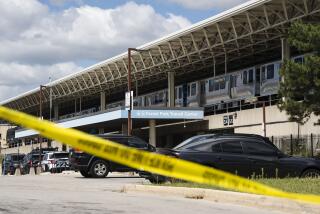3 Killed in Metrolink’s Worst Accident
GLENDALE — In the worst fatal accident in Metrolink’s two years of service, a little girl, her mother and her grandfather were killed in Glendale on Monday as they apparently sought a shortcut to visit the girl’s ailing grandmother, authorities said.
The accident occurred shortly after 10 a.m., underneath a car and pedestrian bridge at 900 Western Ave., just east of the Golden State Freeway. The victims--Antonio Juan Pina, 79, his daughter Miylem Blanca Villanueva, 37, and 7-year-old granddaughter Francis Villanueva of Glendale--were thrown 100 feet through the air by the 60-m.p.h. train, and died instantly, authorities said.
“It’s terrible,” said Glendale Police spokesman Chahe Keuroghelian.
The deaths brought to nine the fatalities caused by Metrolink trains so far this year, and 21 since the service started in October, 1992.
According to witnesses and others interviewed by police, the victims were walking to a nearby convalescent hospital and crossed the tracks to save time, rather than going up and over the Western Avenue bridge. It was not known if they saw the train coming at them, even though the engineer was urgently sounding his horn, according to Metrolink spokesman Peter Hidalgo.
The father of the youngest victim sprinted to the scene from his job nearby after learning from co-workers that three people had been killed on the tracks. Once there, he was faced with the task of identifying the bodies.
“He knew that his family members were going to visit grandma around that time of day and came to the scene to get further information,” Keuroghelian said, adding that police would not release the man’s name. “He was shocked. In disbelief . . . he has lost most of his family.”
The father has another daughter, who is about 10 years old, Keuroghelian said.
A neighbor of the Villanueva family, Catalina Nuno, said they frequently crossed the tracks because that was the quickest route to the nearest bus stop.
“Everyone we know does it,” said Nuno. “I’m just sad. They were real good.” After the accident, which attracted onlookers from nearby commercial buildings, the 22 passengers were transferred to an Amtrak train that was also headed to downtown Los Angeles.
Glendale police interviewed witnesses throughout the day Monday, and Metrolink authorities said they would be conducting their own inquiry to see if any safety measures were overlooked.
Just before the fatal accident, the train had left the Burbank station on its trip south from Santa Clarita. When the engineer saw the victims, it was too late to stop or even slow down, Metrolink authorities said.
“These people came out of nowhere,” Hidalgo said. “They were trying to beat our train and illegally cross the tracks.”
According to Hidalgo, the engineer--whom authorities also declined to identify--was sounding his horn even before he saw the victims on the tracks as a warning to construction crews working in the area. At the first sight of the three, he hit his emergency brakes, but Hidalgo said it takes the 350-ton trains a quarter of a mile to come to a complete stop when they are moving that fast.
Hidalgo defended the engineer, who he said was distraught over the deaths and would be offered psychological counseling, as are all engineers involved in fatal collisions.
Hidalgo also reiterated a Metrolink response to such incidents, many of which have occurred after people wandered onto sections of track that are off-limits to the public.
“They were apparently trying to take a shortcut via our tracks, instead of going up and over the bridge,” Hidalgo said. “In their attempt to take the shortcut, it resulted in this fatality.
“What is important to know here is that our tracks are private property. It is a restricted area,” he said.
The incident did not occur at a crossing, and there were no warning signs posted. Although sections of the Metrolink tracks are fenced in to prevent pedestrians from trying to cross, the stretch where the deaths occurred was not fenced.
Hidalgo said he based his description of the moments leading up to the fatal crash on statements taken by Glendale police from the engineer and at least one “credible witness” at the scene.
Several witnesses said another train obstructed the family’s view of the train that killed them, but Hidalgo disputed those accounts, saying the other train was headed north and had stopped several hundred feet from the site of the accident.
“There was no way that the pedestrians could not have seen or heard our train coming,” he said.
Accounts of what the victims were doing when they were hit also differed. Some speculated that the family had been trying to race across the tracks. One said they might have been lying down when they were struck.
The victims, said witness Edward Fayton, “must have been laying down ‘cause I didn’t see anything. (The train engineer) was laying on his horn and kept hitting his horn and hit ‘em.”
Hidalgo replied: “We cannot speculate. We do not know their motivation. There were rumors flying. We have not acknowledged those rumors. We are going by our engineer’s testimony and credible witnesses, based on what the Glendale police told us.”
More to Read
Sign up for Essential California
The most important California stories and recommendations in your inbox every morning.
You may occasionally receive promotional content from the Los Angeles Times.









